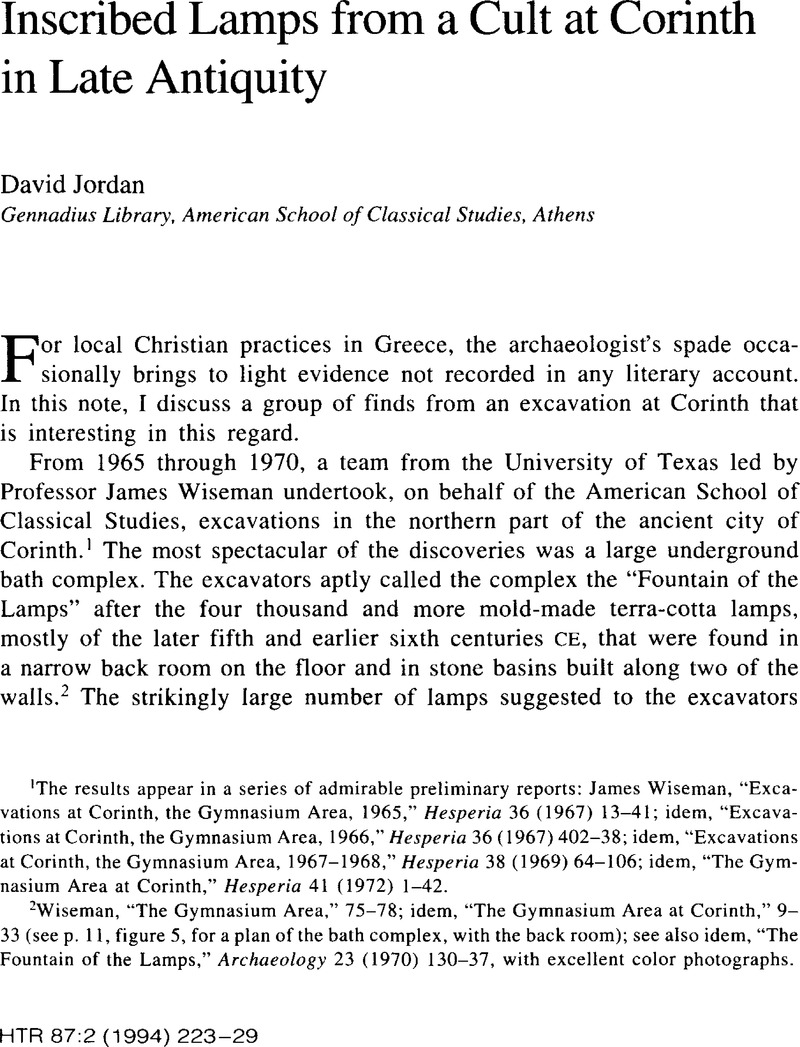No CrossRef data available.
Article contents
Inscribed Lamps from a Cult at Corinth in Late Antiquity
Published online by Cambridge University Press: 10 June 2011
Abstract

- Type
- Notes and Observations
- Information
- Copyright
- Copyright © President and Fellows of Harvard College 1994
References
1 The results appear in a series of admirable preliminary reports: Wiseman, James, “Excavations at Corinth, the Gymnasium Area, 1965,” Hesperia 36 (1967) 13–41CrossRefGoogle Scholar; idem, “Excavations at Corinth, the Gymnasium Area, 1966,” Hesperia 36 (1967) 402–38CrossRefGoogle Scholar; idem, “Excavations at Corinth, the Gymnasium Area, 1967–1968,” Hesperia 38 (1969) 64–106CrossRefGoogle Scholar; idem, “The Gymnasium Area at Corinth,” Hesperia 41 (1972) 1–42.Google Scholar
2 Wiseman, “The Gymnasium Area,” 75–78; idem, “The Gymnasium Area at Corinth,” 9— 33 (see p. 11, figure 5, for a plan of the bath complex, with the back room); see also idem, “The Fountain of the Lamps,” Archaeology 23 (1970) 130–37Google Scholar, with excellent color photographs.
3 Wiseman, “The Gymnasium Area at Corinth,” 26–28.
4 For a study of the types and the chronology of the lamps see Garnett, Karen S., “Late Roman Corinthian Lamps from the Fountain of the Lamps,” Hesperia 44 (1975) 173–205.CrossRefGoogle Scholar
5 Wiseman, “The Gymnasium Area at Corinth,” 28–32, nos. 21–24.
6 I thank Professor Wiseman for encouraging me to publish the new readings of the graffiti on the lamps. For a preliminary announcement see my “Angels in the ‘Fountain of the Lamps’ at Corinth,” XVe Congrès International d'Études Byzantines, Résumés des Communications, vol. 3: Art et Archéologie (Athens: L'Association d'études byzantines, 1976) [25].Google Scholar
7 Published text and translation: 1(Cross.)”Αγγελοι οί κατο[ι]κοῦντ<ες> ἐπὶ το<ῖς> Ἰουδα<ί>2οιςτούτοις; “Angels who dwell below among these Jews.”
8 Published text and translation: 1[ὁρκίζω] σε τὸν 2[μέγαν] θεὸν Σαβαώ 3[τὸν] Ἰάωατὸν 4Βὴλ ὅπως 5ποιήση(=ει)ς <καλ>ῶς 6ώςταῶτα ϕῶσον 7ἔτος ω ἀτ[έκμ]αρ[τον]; “I adjure you, great God Sabaoth, Iao, Baal, that you kindly bring it to pass that the 8OOth boundless year swell to fullness with these things.”
9 Published text and translation: (Side A)1εύκατάλλακτοι 2γένος θ(εοῦ) Ἰη(σοῦ)(Side B)3 3Δούλη ύψ(ίστου) ών(?) 4Φωῖβοι; “You who can be appeased; Jesus, child of God. The slave of the Most High God, bought for Phoebus (dedicates this lamp).”
10 Published text: (Side A) ἀπί[ξ]ου ἰατρὸς Ἔρω(ς)4εὗ τύχή
11 Formulas beginning with ὡς are familiar in texts of sympathetic magic, for example, ὡς ταῦτα τὰ ὀνόματα ψύχεται, οὕτως ψυχέσθω τὸ ὄνομα καὶ ή ψυχή, etc., (“as these [sc. inscribed] names are chilled, so too let the name and the soul… be chilled”), a recurrent phrase in a series of third-century lead curse tablets from the Athenian Agora (SEG 35.213– 27), but nothing in the text as preserved on the lamp demands the assumption of sympathetic magic. It is conceivable that there is some connection between the ὡς TA[ here and the ΩΣ/ΩΣ ταῦτα in lines 5–6 of Lamp 2.
12 For a discussion of the episode see Haenchen, Ernst, A Commentary on the Gospel of John (2 vols.; trans. Funk, Robert W.; Philadelphia: Fortress, 1984) 1. 242–45.Google Scholar
13 He observes, for example, that the water turns a muddy red when the pool is disturbed; see Itinerarium a Bordigala Hierusalem usque…, in Tobler, Titus, ed., Itinera Hierosolymitana et descriptiones Terrae Sanctae (2 vols. in 1; Geneva: Fick, 1877) 1.1.17Google Scholar; see also Wilson, C. W., ed., Itinerary from Bordeaux to Jerusalem (trans. Stewart, Aubry; Palestine Pilgrims' Text Society 1; London: Palestine Exploration Fund, 1887) 20Google Scholar; Wilson's “Appendix III” (pp. 45–55) has a good discussion of pilgrims’ references to the pool.
14 Sanctimonialis Heydenheimensis (Hugeburc), Hodoeporicon S. Willibaldi, in Tobler, Itinera Hierosolymitana, 1.2. 264 (chap. 19).
15 Professor Ronald Stroud, who was kind enough to read a draft of this note, reminds me that the “Fountain of the Lamps” was located quite near the Corinthian Asklepieion, where waters evidently figured in the healing. For the excavations, see Roebuck, Carl A., The Asklepieion and Lerna (Corinth 14; Princeton: American School of Classical Studies, 1951)Google Scholar; compare Lang, Mabel L., Cure and Cult in Ancient Corinth: A Guide to the Asklepieion (Corinth Notes 1; Princeton: American School of Classical Studies, 1977).Google Scholar For a good, skeptical, general introduction to the problem of identifying Christian continuities of pagan cult see Gregory, Timothy E., “The Survival of Paganism in Christian Greece: A Critical Essay,” AJP 107 (1986) 229–42.Google Scholar
16 Maximilian Bonnet, Acta Philippi et Acta Thomae, accedunt Acta Barnabae, in Lipsius, Richard A. and idem, eds., Acta apostolorum apocrypha (2 vols. in 3; 1903; reprinted Darmstadt: Wissenschaftliche Buchgesellschaft, 1959 and Hildesheim: Olms, 1972) 2.2. xx.Google Scholar
17 James, M. R., The Apocryphal New Testament, Being the Apocryphal Gospels, Acts, Epistles, and Apocalypses, with Other Narratives and Fragments Newly Translated (Oxford: Clarendon, 1924) 364.Google Scholar
18 Otto, Walter, “Hyndopherres,” PW 9 (1916) 183–91.Google Scholar
19 The text and translation are those of James, The Apocryphal New Testament, 375.
20 Ibid.
21 Hermary, Antoine, Cassimatis, Hélène, and Vollkommer, Rainer, “Eros,” Lexicon lconographicum Mythologiae Classicae 3.1 (1986) 850–942, esp. 880–81, nos. 366–69Google Scholar; see also Blanc, Nicole and Guy, Franchise, “Amor, Cupido,” Lexicon Iconographicum Mythologiae Classicae 3.1 (1986) 974–76, nos. 146–64.Google Scholar




